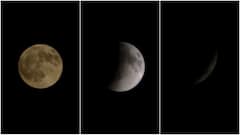Earth May Not Have Been Formed The Way We Think It Did. A Chemical Element Reveals Clearer Picture
Krypton from the Earth’s deep mantle reveals a clearer picture of how our planet formed, a new research by University of California, Davis, says.

New Delhi: A new research from the University of California, Davis, reveals a clearer picture of how Earth formed, and contradicts a popular theory. The study was published on December 15 in the journal, Nature. The researchers collected Krypton from geologic hot spots in Iceland and the Galapagos Islands as part of the study.
The different isotopes of Krypton serve as chemical fingerprints for scientists searching for the ingredients that made Earth, such as solar wind particles and meteorites from the inner and outer solar system. However, a popular theory states that Earth's volatile elements were mostly delivered near the end of Earth's formation, marked by a giant impact that created the Moon. However, the findings of the new study indicate that Earth's volatile elements — such as carbon and nitrogen, and essential compounds such as water — reached our planet when it was growing into one.
The Krypton isotopes obtained by the scientists suggest that planetsimals (tiny parts of a planet) from the cold outer solar system, which has Neptune and Uranus, bombarded Earth millions of years before a small planet collided with our planet to form the Moon. When the Earth was young, it vacuumed up dust and gaseous particles from the solar nebula, which is the cloud surrounding the Sun. The Earth may have been bombarded by meteorites during the early stages of its formation, the study said.
Sandrine Péron, the lead author of the study, said the results provide clues for the sources and timing of volatile accretion on Earth, and will help researchers better understand how Earth formed, according to a statement by the University of California, Davis. She said the findings will also help researchers better understand other planets in the solar system and around stars other than the Sun.
Primordial Geochemistry Of Earth
Magma plumes rising from the deepest layer of Earth's mantle, which is near the boundary of the planet's iron core, are responsible for the volcanic hot spots in Iceland and the Galapagos, and are rich in minerals and elements that act like time capsules. This is because the elements and minerals have remained relatively unchanged since before the Moon-forming impact, the study said. They can provide a glimpse of early Earth's chemistry more than 4.4 billion years ago.
The researchers collected lava at hot spot plumes to sample deep mantle krypton. As the erupting lava solidifies, the ancient gases rise to the surface, and get trapped as bubbles in a glassy matrix.
Professor Sujoy Mukhopadhyay, another researcher of the study, said the detection of the krypton isotopes in these bubbles is challenging because they amount to only a few hundred million atoms.
The technique used by Péron for measuring mantle krypton with mass spectrometry (analytical technique used to quantify materials, identify unknown compounds) was devised by her. The technique helped the researchers concentrate krypton from rock samples in an environment free if air contamination.
The scientists neatly separated krypton from argon and xenon.
Péron said this is the first study to precisely measure all krypton isotopes for the mantle, including the rarest krypton isotopes, which are Kr-78 and Kr-80.
Earth Was Formed From Different Sources
The chemical fingerprint of deep mantle krypton closely resembled primitive, carbon-rich meteorites, which may have been delivered from the cold, outer reaches of the solar system, the study found. Previous research conducted by Mukhopadhyay found that neon, which is another noble gas like krypton, was derived from the Sun. These differences suggest at least two distinct volatile sources for Earth's mantle, which were delivered very early in the history of the planet's formation.
The findings also have implications for how Earth's atmosphere arose. The researchers found that the ratio of different krypton isotopes in the deep mantle does not match the isotope ratio in Earth's atmosphere. This suggests that some gases in the atmosphere were delivered to Earth after the moon-forming impact, the study said.
Had this not been the case, Earth's mantle and atmosphere would have had the same isotopic composition. The fact that the isotopic compositions of Earth's mantle and atmosphere are different suggests that certain elements in Earth's mantle were delivered several eons before the Moon-forming impact.







































